#woolly mammoth
Text
🐘 Elephants are part of a group called proboscideans, named for their proboscis, or trunk. Learn more about elephants and their relatives in The Secret Life of Elephants, open on November 13!
🌟 Members see it first!
#science#museum#amnh#natural history#video#paleontology#animals#did you know#fact of the day#elephants#proboscideans#woolly mammoth#mammoth#dwarf elephant#mammalogy#fun facts#things to do in new york city
340 notes
·
View notes
Text


Here's some Mammuthus primigenius reconstructions to start your day. Fossil evidence shows that good parents would knit festive scarves to keep their babies warm while their thick fur was growing in.
#illustration#paleoart#art#paleontology#paleo#sciart#artistsontumblr#digitalart#science#digitalillustration#woolly mammoth#mammoth#ice age
329 notes
·
View notes
Text

just a little reminder that it's okay to be tired, friends <3
[ID copied from Alt Text: Marker art of a woolly mammoth with text reading "It's okay if you're tired. The world is a lot, and I'm so proud of you for continuing on." End ID.]
Instagram | Etsy
#watercolour critters art#accessible art#messy encouragement cards#art#marker art#woolly mammoth#encouragment
240 notes
·
View notes
Text


Woolly rhino and woolly mammoth! 🦣 Two prehistoric pals! ✨
#fursuit#fursuit making#fursuit maker#furry artist#furry fandom#furry#woolly rhinoceros#woolly mammoth
75 notes
·
View notes
Text
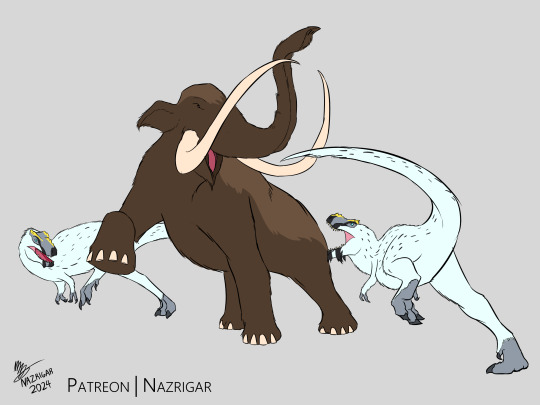
A commission for @thewoollyviking !
Two Nanuqsaurus' attempting to hunt a Woolly Mammoth!
83 notes
·
View notes
Photo

A female woolly Mammoth stands alone to mourn the loss of her young calf.
#my art#mammoth#woolly mammoth#mammal#prehistoric mammal#prehistoric#prehistoric art#paleontology#paleoart#paleoillustration#Illustration#ice age#snow#not#a#dinosaur#not even close
595 notes
·
View notes
Text
Strange Symmetries #22: The Whalerus And The Twisted Tusks
Mammalian tusks usually grow in symmetrical pairs with only minor developmental asymmetry, but a few species have evolved much more uneven arrangements.

Odobenocetops peruvianus was a small toothed whale that lived during the Miocene, about 7-3 million years ago, in shallow coastal waters around what is now Peru. Around 3m long (~10'), it was a highly unusual cetacean with binocular vision, a vestigial melon, muscular lips, and a pair of tusks – features convergent with walruses that suggest it had a similar lifestyle suction-feeding on seafloor molluscs and crustaceans.
In males the right tusk was much more elongated than the left, measuring around 50cm long (~1'8") in this species and up to 1.35m (4'5") in the closely related Odobenocetops leptodon. Since these teeth were quite fragile they probably weren't used for any sort of combat, and they may have instead served more of a visual display function.
And despite being closer related to modern narwhals and belugas than to other toothed whales, Odobenocetops' long right-sided asymmetric tusks actually seem to have evolved completely independently from the iconic left-sided asymmetric spiral tusks of narwhals.
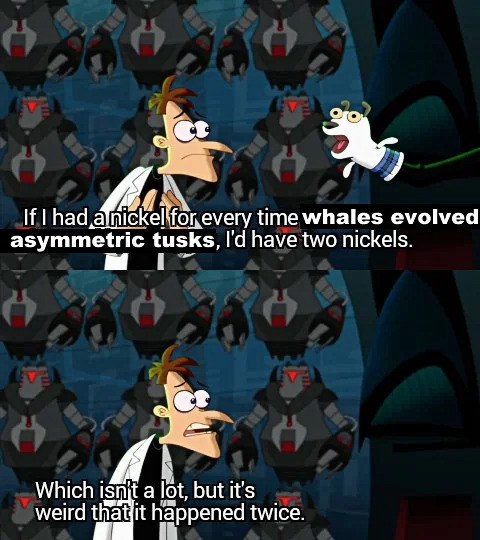
———

The woolly mammoth (Mammuthus primigenius) lived across Eurasia and North America during the last ice age, mostly from the Pleistocene about 400,000 years ago to the early Holocene about 10,000 years ago – altohugh a few relict populations survived until around 4,000 years ago in isolated areas of Alaska, Siberia, and eastern Russia.
Around 3m tall at the shoulder (~10ft), these hairy proboscideans had very long curving tusks that were used for digging out vegetation from under snow and ice, scraping bark from trees, and for fighting.
The tusks showed a lot of variation in their curvature, and were often rather asymmetrical, a condition also seen in the closely related Columbian mammoth. Like modern elephants mammoths may have also favored using one side over the other for certain tasks, which over their lifetimes could result in uneven wear exaggerating the natural asymmetry even more.
———
NixIllustration.com | Tumblr | Twitter | Patreon
#science illustration#strange symmetries#paleontology#paleoart#palaeoblr#tusks#odobenocetops#delphinoidea#odontoceti#toothed whale#cetacean#whale#artiodactyla#ungulate#marine mammal#woolly mammoth#mammuthus#elephant#proboscidea#afrotheria#mammal#art#whalerus#behold‚ a walrus!
346 notes
·
View notes
Text


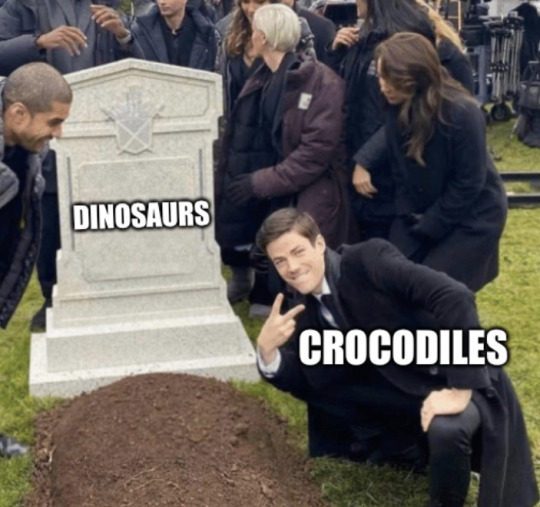
Have some old paleontology memes I made
341 notes
·
View notes
Text

Cryptids & Creatures of Folklore Drawtober Day 5 — Woolly Mammoth
Woolly Mammoths were most definitely real animals but they sadly went extinct a few thousand years ago.
However, there have been reports of hairy, elephant-like creatures encountered in Canada within the last few centuries by the Dene, the Inuit, and other First Nations peoples, American and French fur traders, and other hunters and explorers of the region. Some sightings were as recent as the early 1900s.
137 notes
·
View notes
Text
Mammoths!

Love these big guys. Wanted to draw them playing because I feel that I don't see much paleoart of that.
#mammuthus#mammuthus primigenius#mammoth#ice age#cenozoic#paleoart#paleoblr#quarternary#woolly mammoth#paleontology#nature#yee art
62 notes
·
View notes
Text
Some dead friends from a weekend trip to the museum.
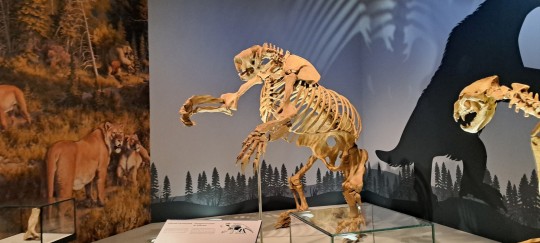
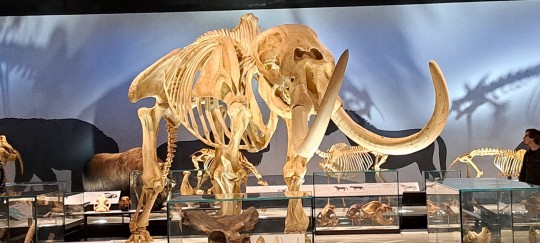



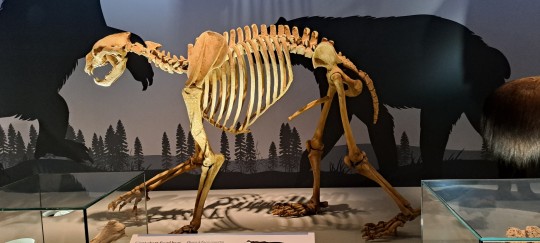
#jeffersons ground sloth#american mastodon#woolly mammoth#smilodon#short faced bear#steppe bison#paige rambles#museum trip#friend shaped#American lion
245 notes
·
View notes
Text

🦣 Did you know? Like musk oxen today, scientists think mammoths grew thick coats of underfur during winter and then shed them in the spring. Long outer, or guard, hairs are often found scattered about in mammoth sites. You can get a close look at this life-size mammoth model in the Museum’s upcoming exhibition: The Secret World of Elephants. Join today!
Photo: A. Keding / © AMNH
#science#amnh#museum#fossil#natural history#nature#paleontology#animals#mammoth#mastodon#elephant#proboscideans#ice age#woolly mammoth
244 notes
·
View notes
Text
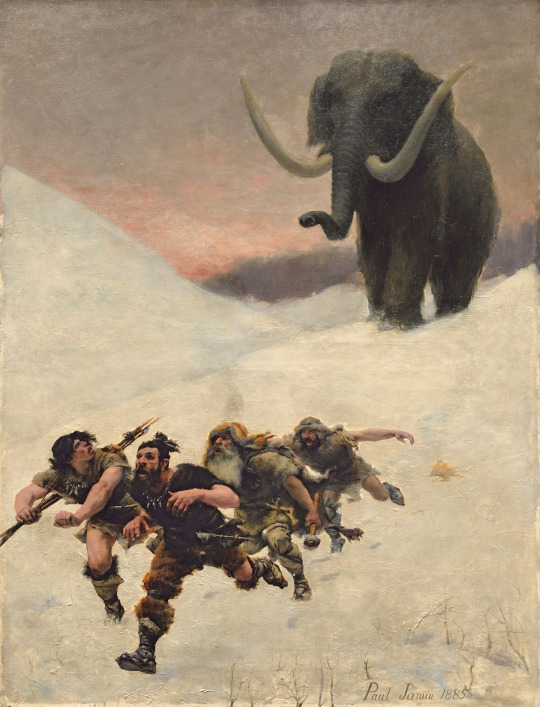
The Flight before the Mammoth - La fuite devant le mammouth
by Paul Jamin
#prehistoric#animals#mammoths#mammoth#neanderthal#neanderthals#art#paul joseph jamin#paul jamin#history#winter#snow#prehistoric animals#woolly mammoth
416 notes
·
View notes
Text
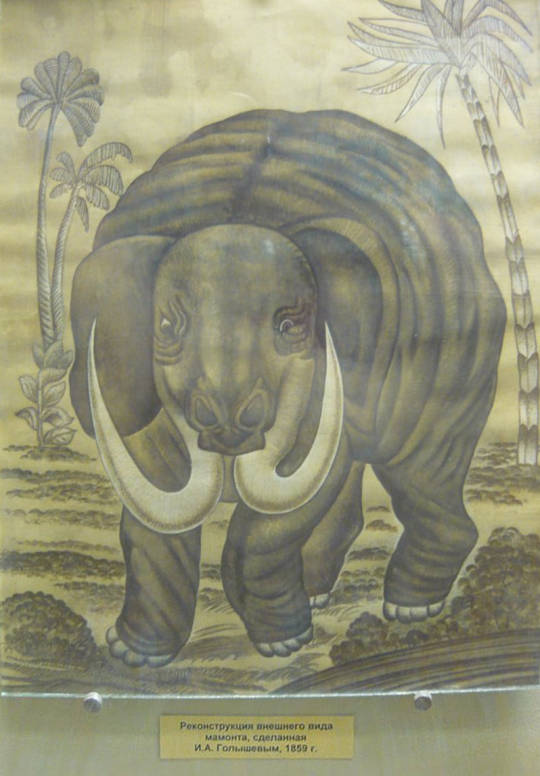
Mammoth lithograph by Ivan Alexandrovich Golishev, 1859 on display at Orlov Museum, Moscow
Via Velizar Simeonovski's post in Historic Palaeoart Facebook group https://www.facebook.com/groups/historicpalaeoart/posts/624361415458931/
47 notes
·
View notes
Photo


Did you see this preview of my comic on Iron Circus Comics’ Failure to Launch BackerKit project page and wonder: "what ARE all those animal skeletons?!?"
Well wonder no more: here's a version with every species labeled--scientific and common names both!
Read my upcoming comic about de-extinction by supporting the “Failure to Launch” anthology!
#PS we are almost at the next stretch goal *eyes emoji*#failure to launch#de-extinction#extinction#paleoart#paleoblr#skeletons#woolly mammoth#dodo#aurochs#baiji#passenger pigeon#moa#thylacine#megaloceros#recently extinct
304 notes
·
View notes
Photo

The skeleton of a Woolly mammoth, amongst other Pleistocene mammals, on display at the Field Museum of Natural History.
#Palaeoblr#Dinoblr#Field Museum of Natural History#The Field Museum#Woolly mammoth#Mammoth#Pleistocene#Ice Age#Skeletons#Fossils#Photo#Prehistoric#Extinct#Cenozoic
178 notes
·
View notes